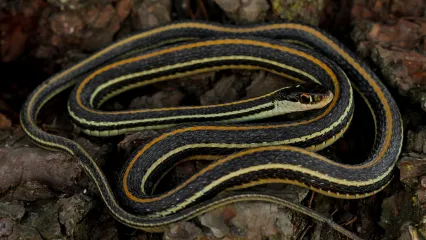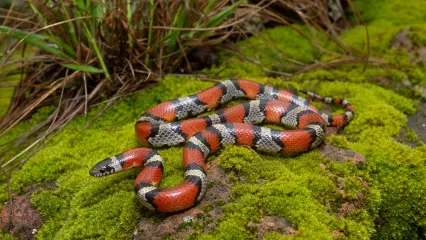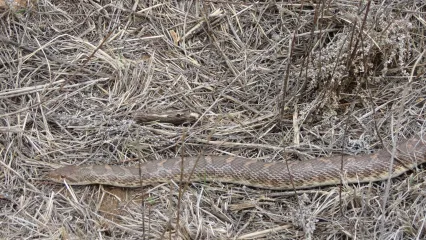
Description
Orange-striped ribbonsnakes are thin-bodied, moderately sized snakes with distinctly keeled scales that can be distinguished from all other snakes in the region by a combination of a dark background color, a very distinct uninterrupted yellow or orange stripe extending from the neck to the tip of the tail, and a well-defined yellow, bluish, or white stripe on the third and fourth scale rows, also extending the full length of the body and tail. The only similar species is the Texas gartersnake, which also has a mid-dorsal yellow stripe and is lateral stripe on each side of the body. The lateral stripe in the Texas gartersnake is on the second and third scale rows. A much easier way to distinguish between these two snakes is to carefully examine the side of the head. The orange-striped ribbonsnake has white along scales of the upper jaw with no markings on them and a distinct vertical white bar in front of the eye preceded by a distinct black mark. The area just behind the eye is black. The Texas gartersnake has white upper labials with distinct vertical black marks between each scale the area in front of and behind the eye is light colored (not white). The belly of the orange-striped ribbonsnakes has no spots or other markings and is cream to bluish in color. Juveniles might be confused with adults of the Texas brownsnake.
Size
Orange-striped ribbonsnakes average between 20 and 30 inches in total length, but can reach nearly 40 inches. Hatchlings are about 12 inches in total length.
Habitat
In Oklahoma, orange-striped ribbonsnakes occur throughout most of the state, with the exception of the far western part of the panhandle. The distribution in North America extends west to east from western New Mexico to Tennessee and north to south from southwestern Wisconsin to the Gulf Coast and into Mexico.
Life Cycle
Orange-striped ribbonsnakes are active from early spring through late fall. They are terrestrial for the most part, but will readily enter water to capture amphibians or to escape predators. Mating occurs from April through May and live young are born in August or early September. The number of offspring varies from about 4-24, with larger females producing more offspring than smaller ones. The possibility exists that some females do not reproduce every year, but rather skip years. This is known to occur in orange-striped ribbonsnakes in Missouri and likely occurs in western Oklahoma as well. Primary food for orange-striped ribbonsnakes is amphibians. They not only eat adult frogs and slamanders, but the larvae as well. They occasionally eat fish also. Juveniles can often be found in low grass surrounding ponds where they search for Blanchard’s cricket frogs. These snakes are harmless to humans.
How To Observe
Like Texas gartersnakes, these snakes are generally common wherever there is water, including ponds, swamps, sloughs, and riverbanks. They can easily be found by searching through grass near water particularly in morning or late afternoon. Orange-striped ribbonsnakes are wary and fast moving, and are most often observed just as they disappear into brush or the water.
(This profile was created by Dr. Laurie Vitt as part of a partnership between the Wildlife Department and the Sam Noble Oklahoma Museum of Natural History. It was funded as part of a larger State Wildlife Grant to survey and inventory amphibians and reptiles of the Wildlife Management Areas of Oklahoma: T-35-P-1.)


